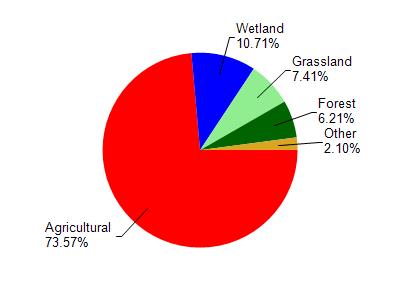Columbia
No
No
No
Fish and Aquatic Life
Overview
The North Branch Crawfish River enters the main branch just below the Village of Fall River. Monitoring indicated polluted agricultural runoff, low levels of dissolved oxygen and low flow problems exist (WDNR, 1994).
Date 2002
Author Aquatic Biologist
Historical Description
Crawfish River, North Branch T11N, R12E, Section 27, Surface Acres = 44.72, Miles = 24.6, Gradient = 3.25 feet per mile.
Major tributary to the Crawfish River, flowing northeast then southeast to
join the mainstream south of the Fall River Millpond (Lazy Lake). A dam with
14-foot head impounds nearly 2.5 miles of channel at Fall River. Largemouth
bass, nothern pike, and several of the panfishes constitute the fishery. Carp are
abundant, hence a use problem. Access is possible at numerous road crossings
and a launching site exists at the millpond. About 607 acres of wetland adjoin the stream.
From: Poff, Ronald J. and C.W. Threinen, 1965. Surface Water Resources of Columbia County:
Lake and Stream Classification Project. Wisconsin Conservation Department, Madison, WI.
Date 1965
Author Surface Water Inventory Of Wisconsin
Condition
Wisconsin has over 84,000 miles of streams, 15,000 lakes and milllions of acres of wetlands. Assessing the condition of this vast amount of water is challenging. The state's water monitoring program uses a media-based, cross-program approach to analyze water condition. An updated monitoring strategy (2015-2020) is now available. Compliance with Clean Water Act fishable, swimmable standards are located in the Executive Summary of Water Condition in 2018. See also the 'monitoring and projects' tab.
Reports
Recommendations
Lakes Planning Grant
Aquatic Plant Monitoring or Survey
Aquatic Plant Management Plan
Update
Water Quality Modeling
Wastewater Monitoring or Management
Nutrient Budget Development
Monitor Water Quality or Sediment
Management Goals
Wisconsin's Water Quality Standards provide qualitative and quantitative goals for waters that are protective of Fishable, Swimmable conditions [Learn more]. Waters that do not meet water quality standards are considered impaired and restoration actions are planned and carried out until the water is once again fishable and swimmable
Management goals can include creation or implementation of a Total Maximum Daily Load analysis, a Nine Key Element Plan, or other restoration work, education and outreach and more. If specific recommendations exist for this water, they will be displayed below online.
Monitoring
Monitoring the condition of a river, stream, or lake includes gathering physical, chemical, biological, and habitat data. Comprehensive studies often gather all these parameters in great detail, while lighter assessment events will involve sampling physical, chemical and biological data such as macroinvertebrates. Aquatic macroinvertebrates and fish communities integrate watershed or catchment condition, providing great insight into overall ecosystem health. Chemical and habitat parameters tell researchers more about human induced problems including contaminated runoff, point source dischargers, or habitat issues that foster or limit the potential of aquatic communities to thrive in a given area. Wisconsin's Water Monitoring Strategy was recenty updated.
Grants and Management Projects
Monitoring Projects
| WBIC | Official Waterbody Name | Station ID | Station Name | Earliest Fieldwork Date | Latest Fieldwork Date | View Station | View Data |
|---|
| 843100 | North Branch Crawfish River | 113141 | Crawfish River-North Branch - Hwy Z | 7/8/2019 | 9/30/2019 | Map | Data |
| 843100 | North Branch Crawfish River | 10017299 | North Branch Crawfish River At Cth Dg | 5/9/1979 | 5/9/1979 | Map | Data |
| 843100 | North Branch Crawfish River | 10028841 | North Branch Crawfish River at Hall Rd | 8/11/2008 | 6/3/2022 | Map | Data |
| 843100 | North Branch Crawfish River | 10045070 | N. Br. Crawfish River at CTH CD | 1/1/2015 | 9/30/2016 | Map | Data |
|

Watershed Characteristics
North Branch Crawfish River is located in the Upper Crawfish River watershed which is 161.18 mi². Land use in the watershed is primarily agricultural (73.50%), wetland (10.70%) and a mix of grassland (7.40%) and other uses (8.30%). This watershed has 228.16 stream miles, 731.69 lake acres and 11,027.15 wetland acres.
Nonpoint Source Characteristics
This watershed is ranked High for runoff impacts on streams, Low for runoff impacts on lakes and High for runoff impacts on groundwater and therefore has an overall rank of High. This value can be used in ranking the watershed or individual waterbodies for grant funding under state and county programs.However, all waters are affected by diffuse pollutant sources regardless of initial water quality. Applications for specific runoff projects under state or county grant programs may be pursued. For more information, go to surface water program grants.